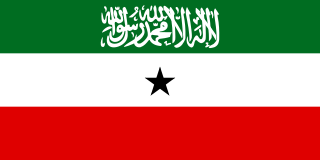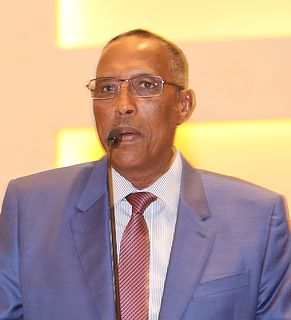Djibouti is a country in the Horn of Africa. It is bordered by Somalia to the southeast, Eritrea and the Red Sea to the north and northeast, Ethiopia to the west and south, and the Gulf of Aden to the east.

Somalia, officially the Federal Republic of Somalia and formerly known as the Somali Democratic Republic, is a country located in the Horn of Africa.

British Somaliland, officially the British Somaliland Protectorate, was a British protectorate in present-day Somaliland. For much of its existence, the territory was bordered by Italian Somalia, French Somali Coast and Ethiopia. From 1940 to 1941, it was occupied by the Italians and was part of Italian East Africa. On 26 June 1960, British Somaliland declared independence as the State of Somaliland. On 1 July 1960, the State of Somaliland united, with the Trust Territory of Somalia to form the Somali Republic (Somalia). The government of Somaliland, a self-declared sovereign state that is internationally recognised as an autonomous region of Somalia, regards itself as the successor state to British Somaliland.

Puntland, officially the Puntland State of Somalia, is a region in northeastern Somalia. Centred on the town of Garoowe in the Nugal province, its leaders declared the territory an autonomous state in 1998 but is internationally recognized as an autonomous region of Somalia.

Hargeisa is a city situated in the Woqooyi Galbeed region of the self-declared but internationally unrecognised Republic of Somaliland in the Horn of Africa. It is the capital and largest city of Somaliland.

Mohamed Haji Ibrahim Egal was a Somali politician. He was the first prime minister of the Somali Republic during the early and late 1960s. He also served as the President of the Republic of Somaliland, a self-declared de facto sovereign state that is internationally recognized as a separate and self-governing autonomous region of Somalia, from 1993 to 2002. he hails from the Rer Balle sub clan of the Issa Musse subdivision of the Isaaq

The Ogaden War was a Somali military offensive between July 1977 and March 1978 over the disputed Ethiopian region of Ogaden, which began with the Somali invasion of Ethiopia. The Soviet Union disapproved of the invasion and ceased its support of Somalia, instead starting to support Ethiopia; the United States, conversely, ceased its support of Ethiopia and started supporting Somalia. Ethiopia was saved from a major defeat and a permanent loss of territory through a massive airlift of military supplies, the arrival of 16,000 Cuban troops, 1,500 Soviet advisors and two brigades from South Yemen, also airlifted to reinforce Harar. The Ethiopians prevailed at Harar, Dire Dawa and Jijiga, and began to push the Somalis systematically out of the Ogaden. By March 1978, the Ethiopians had captured almost all of the Ogaden, prompting the defeated Somalis to give up their claim to the region. A third of the initial Somali National Army invasion force was killed, and half of the Somali Airforce destroyed; the war left Somalia with a disorganized and demoralized army and an angry population. All of these conditions led to a revolt in the army which eventually spiraled into a civil war and Somalia's current situation.

The Somali Republic was the official name of Somalia after independence on July 1, 1960, following the unification of the Trust Territory of Somaliland and the State of Somaliland. A government was formed by Abdullahi Issa Mohamud and Muhammad Haji Ibrahim Egal and other members of the trusteeship and protectorate administrations, with Haji Bashir Ismail Yusuf as President of the Somali National Assembly and Aden Abdullah Osman Daar as President of the Somali Republic. On 22 July 1960, Daar appointed Abdirashid Ali Shermarke as Prime Minister. On 20 July 1961 and through a popular referendum, the people of Somalia ratified a new constitution, which was first drafted in 1960. The administration lasted until 1969, when the Supreme Revolutionary Council (SRC) seized power in a bloodless putsch and renamed the country the Somali Democratic Republic.

Ahmed Mohamed Mohamoud "Silanyo" is a Somaliland politician who was President of Somaliland from 2010 - 2017. He is a longtime member of government, having served as Minister of Commerce of Somalia, among other Cabinet positions. During the 1980s, he also acted as Chairman of the Somali National Movement.

The politics of Somaliland take place within a hybrid system of governance, which, under the Somaliland region's constitution, combines traditional and western institutions. The constitution separates government into an executive branch, a legislative branch, and a judicial branch, each of which functions independently from the others.

Presidential elections in Somaliland, an autonomous region of Somalia, were held on 14 April 2003. Results showed that president Dahir Riyale Kahin won by the slightest of margins. The outcome was initially rejected by the main opposition which led to some violence in the country, spurring Somaliland to ban public protests for a 10-day period on April 22. Nevertheless, the International Crisis Group labeled the election a democratic "milestone" for the breakaway state. On 11 May 2003, the Somaliland Supreme Court endorsed Kahin's victory. On 16 May 2003, Kahin was sworn in as Somaliland's first democratically elected President.

Foreign relations of the Republic of Somaliland are the responsibility of the Ministry of Foreign Affairs. The Republic of Somaliland. The region's self-declared independence remains unrecognised by the international community.

The State of Somaliland was a short-lived independent state in the territory of present-day northwestern Somalia. It was the name assumed by the former British Somaliland protectorate in the five days between June 26, 1960 and July 1, 1960, when the territory prepared for union as scheduled with the Trust Territory of Somaliland under Italian Administration to form the Somali Republic (Somalia).

The Somali Youth League (SYL), initially known as the Somali Youth Club (SYC), was the first political party in Somalia. It played a key role in the nation's road to independence during the 1940s, 1950s and 1960s.

The following outline is provided as an overview and topical guide to Somaliland:

Presidential elections were held in Somaliland on 13 November 2017, the third direct presidential election since 2003. General elections had been scheduled to be held in Somaliland on 27 March 2017 to elect both the President and House of Representatives, but were initially postponed by six months due to the drought condition in the region. The elections to elect the President and Vice President were eventually held separately on 13 November. Incumbent President Ahmed Mohamed Mohamoud of the Peace, Unity, and Development Party (KULMIYE) did not run for a second term.
The BBC Somali Service is a BBC World Service radio station transmitted in the Somali language and based in Broadcasting House in West London. The current Head of BBC Somali Service is Abdullahi Abdi Sheikh, a Somali journalist, who joined the service in 2011. Former Head Yusuf Garaad Omar, a Somali journalist, who joined in 1992, resigned in August 2012. Most of the listeners live in the Horn of Africa and nearby regions. According to the station, it provides a key link between those in Somalia and those elsewhere.

Musa Bihi Abdi is a Somaliland politician and former military officer who has been President of Somaliland since December 2017. During the 1970s, he served as a pilot in the Somali Air Force under the Siad Barre administration. In 2010, Bihi was appointed the Chairman of the ruling Kulmiye in the self-declared Republic of Somaliland. In November 2015, Bihi was selected as the party's Presidential Candidate at the 5th annual central committee convention.






















